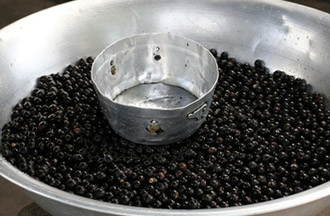Selection and storage
Fresh acai is typically only found in proximity to acai palm plantations. Acai fruits are usually harvested twice a year, with skilled workers adept at climbing trees to collect fully ripe clusters from the uppermost parts of the acai palm.
Acai is extremely perishable, and once it’s harvested, it must either be consumed promptly or transported to processing facilities.
Various commercial acai products can be found in stores, including freeze-dried whole acai berries. However, it’s important to note that these freeze-dried berries are nutritionally inferior to fresh ones.
Preparation and serving methods
 |
| Acai berries put for sale. Courtesy: borderlys |
The edible part of the acai fruit is the outer peel or pulp known as the mesocarp. The seeds are either discarded or used as animal fodder.
Here are some suggestions for serving acai:
-
Acai juice, a refreshing beverage with a distinct nutty flavor, is typically made by macerating ripe berries. To prepare it, ripe berries are soaked in lukewarm water to soften their thin outer flesh. They are then squeezed, and the large seeds are strained out, resulting in a thick, purple, creamy liquid.
-
Acai drinks, whether freeze-dried or in powdered juice form, are quite popular in the Americas, especially in Brazil.
-
Traditionally, in the tribal regions of the Amazon, acai extracts are commonly mixed with a starchy root vegetable called manioc and consumed as a delicious porridge.
-
Its extract can be mixed with sugar or sugarcane juice to add sweetness and be enjoyed as a beverage.
-
Acai extract can also be used to flavor ice creams, smoothies, shakes, liquor, and other desserts.
-
Furthermore, acai berries are utilized in energy-boosting nutritional supplements, available in the form of capsules, tablets, and as energy bar snacks.
Acai Palm Hearts
Acai palm hearts refer to the delicate, pale, youthful buds that sprout from the fronds of the acai palm, just above its central growth point on each stem. These hearts are a cherished byproduct of the acai tree and are used as a vegetable in a manner similar to the hearts of oil palms. Typically, they are harvested after felling a live tree stem (trunk) and removing the outer layers to reveal the central core, known as the “palm heart.”
Despite their limited nutritional value, palm hearts are considered a rare delicacy, which is why they command a premium price in the market.
Safety profile
Acai berry consumption has been thoroughly assessed and found to be safe, with no reported contraindications. Pregnant women in the Amazon basin have used it without any safety concerns. To date, no instances of allergies or toxicity have been documented. (Please refer to our Medical disclaimer for more information).
Unveiling the Truth About Acai
-
The Acai berry hails from the Euterpe oleracea palm tree, sharing its botanical family with coconut, date palm, oil palm, and others. Acai’s caloric content primarily stems from its fat content. However, it’s important to note that there is no concrete scientific evidence supporting the idea that consuming acai products aids in weight loss.
-
Acai has been a staple in the Amazonian diet for centuries, serving as a fundamental food item rather than a trendy “superfood” like blueberries or pomegranates, which are notably low in calories.
-
Contrary to some claims found in various sources, acai contains antioxidants in moderate amounts. The USDA has not conducted an in-depth analysis of its nutritional profile or ORAC (Oxygen Radical Absorbance Capacity) value. It’s worth noting that numerous herbs, fruits, berries, and vegetables in nature surpass acai in terms of antioxidant levels. For example, cinnamon an boasts the highest documented USDA ORAC value at 267,536 Trolox equivalents (TE), which is significantly higher than acai, as well as other items like chokeberries and apples.
-
Acai berries are calorie-dense and can provide a quick energy boost. However, it’s essential to recognize that there are no known foods on Earth that are both high in calories and fats while simultaneously promoting weight loss.
-
As of now, there is no documented scientific evidence supporting the use of Acai berries as an aphrodisiac (Medical disclaimer).
≺≺- Back to Fruits from Acai berry nutrition. Visit here for impressive list of all varieties of fruits with complete illustrations of their nutrition facts and health benefits.
≺≺- Back to Home page.
Further Reading:
- NIH-National center for Complementary and Integrative Health. (opens in new window).

